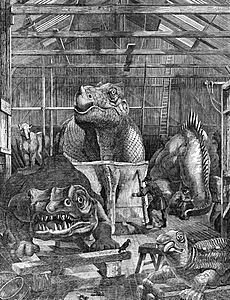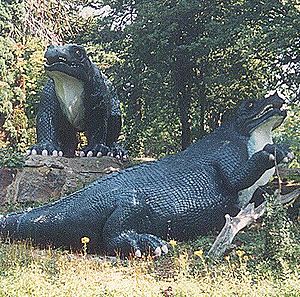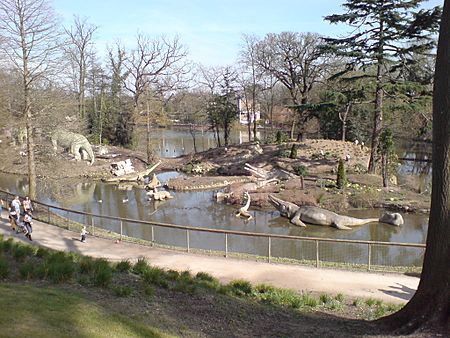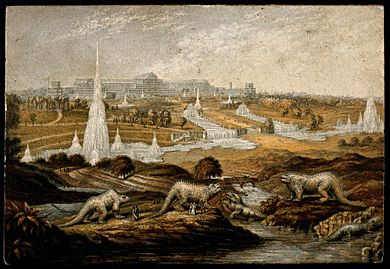Crystal Palace Dinosaurs facts for kids
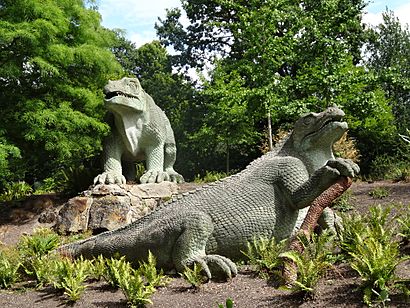
The Crystal Palace Dinosaurs are a collection of sculptures of dinosaurs and other ancient animals. You can find them in Crystal Palace Park in London. They were made a long time ago, in 1852, to go with the Crystal Palace building after it moved from the Great Exhibition in Hyde Park.
These sculptures were shown to the public in 1854. They were the very first dinosaur sculptures ever made! Benjamin Waterhouse Hawkins designed and sculpted them. He worked with a scientist named Sir Richard Owen, who made sure the models were based on the best science of that time.
Today, we know that some of these models are not quite right compared to what scientists know now. This is because paleontology (the study of fossils) was a very new science back then. For example, the Iguanodon model looks quite different from how we imagine Iguanodon today.
These models are also known as Dinosaur Court. They are very important historical artworks. They were made a special "Grade II listed building" in 1973, which means they are protected. They were fixed up in 2002 and then became "Grade I listed" in 2007, showing how special they are.
The models show 15 different types of extinct animals. Not all of them are true dinosaurs! They come from different time periods in Earth's history. Most are from the Mesozoic era, like true dinosaurs, ichthyosaurs, and plesiosaurs. There are also some mammals from the more recent Cenozoic era.
Contents
History of the Dinosaurs
The Great Exhibition closed in October 1851. After that, the Crystal Palace building was bought and moved to Sydenham Hill in South London. The land around it was turned into a public park with beautiful gardens and two new man-made lakes.
As part of this big project, Benjamin Waterhouse Hawkins was asked to create the first life-sized models of extinct animals. He first planned to make only extinct mammals. But then he decided to include dinosaurs too! He got advice from Sir Richard Owen, a famous scientist who studied anatomy and fossils.
Hawkins set up his workshop right in the park. He built the models there, making them full-size out of clay. Then, he made molds from the clay models and cast them in cement. The bigger sculptures are hollow inside and have brickwork to support them.
The models were placed on three islands in the lake. These islands were like a timeline of Earth's history. The first island showed animals from the Paleozoic era. The second island had animals from the Mesozoic era. The third island featured animals from the Cenozoic era. To make them look even more real, the water level in the lake would change, showing different parts of the dinosaurs.
To celebrate the models, Hawkins held a special dinner on New Year's Eve in 1853. Guess where it was? Inside the mold of one of the Iguanodon models!

People loved the dinosaurs! Hawkins even sold smaller versions of the models for schools to use. But building the big models was very expensive, costing about £13,729. In 1855, the Crystal Palace Company stopped giving Hawkins money. Some models that were planned or half-finished were never completed. People protested, but it didn't change anything.
Later, Hawkins worked on a "Paleozoic Museum" in New York's Central Park. This was like an American version of the Crystal Palace Dinosaurs. Sadly, in May 1871, many of his workshop exhibits were destroyed by vandals.
As scientists learned more about dinosaurs, the Crystal Palace models started to seem less accurate. In 1895, a fossil hunter named Othniel Charles Marsh criticized them. Over the years, the models and the park became run down. A big fire destroyed the Crystal Palace building itself in 1936, and the models became hidden by overgrown plants.
In 1952, the animals were fully restored by Victor H.C. Martin. Some of the mammal models were moved to places where they were not as protected, so they got damaged more easily. A limestone cliff in the park was even blown up in the 1960s.
In 2001, the dinosaur display was completely renovated again. The destroyed limestone cliff was rebuilt using huge blocks of Derbyshire limestone. Missing sculptures were replaced with fiberglass copies. Damaged parts of the old models were fixed. For example, some legs were made of lead with iron rods inside. The iron rusted, which made the lead crack.
The models and other parts of Crystal Palace Park were listed as "Grade II listed buildings" in 1973. After the big restoration in 2001, they were upgraded to "Grade I listed" in 2007.
In 2018, a group called "Friends of Crystal Palace Dinosaurs" raised money to build a permanent bridge to Dinosaur Island. The famous guitarist Slash even supported the campaign! The bridge was designed to swing open and close to prevent people from getting onto the island when it's not in use. It was put in place in January 2021.
The Dinosaur Park Animals
There are fifteen different types of extinct animals shown in the park. Remember, not all of them are true dinosaurs! Some other animals were planned, like a Dinornis (a giant bird) and a mastodon (like an elephant). Hawkins even started building the mastodon before his funding was cut in 1855.
Animals from the Palaeozoic Era
The Palaeozoic era is shown by models of rock layers. These layers include rocks from the Carboniferous period (like Coal Measures and limestone) and the Permian period.
- Dicynodon: The two Dicynodon models are based on incomplete fossils found in South Africa. Sir Richard Owen thought they looked like turtles. But today, scientists know that Dicynodon did not have protective shells.
Animals from the Mesozoic Era
The Mesozoic era is shown by models of dinosaurs and other animals from that time. There are also plants, both real and models, that would have lived during the Mesozoic.
- Hylaeosaurus: This model is from the Cretaceous period in England. It looks a bit like an Ankylosaurus, with a bumpy, armored back and spines along its sides. Hawkins's model shows it as a large, iguana-like creature with long, sharp spines. The head of the Hylaeosaurus model is a fiberglass copy; the original head is on the ground nearby.
- Ichthyosaurus: These models are based on fossils from the Triassic or Jurassic periods in Europe. Even though they are partly in the water, they are shown resting on land like seals. Owen thought they looked like crocodiles or plesiosaurs. But better fossils show they were more like sharks, with a dorsal fin and a fish-like tail. In Hawkins's models, the tail is flat and comes straight off the backbone. These models are one of the three mascots of Crystal Palace Park, even though ichthyosaurs are not dinosaurs!
- Iguanodon: These models represent fossils from the Jurassic and Cretaceous periods in Europe. When the first Iguanodon fossil was found, scientists thought its thumb bone was a nose horn! This "nose horn" is often used in books and documentaries to show how early dinosaur ideas were wrong. Even in 1854, Owen said the horn was "more than doubtful."
- Labyrinthodon: Three Labyrinthodon models were made. Owen thought these Triassic animals, which lived in water, might have looked like frogs. He even named them "Batrachia," which means "frog" in Greek.
- Megalosaurus: This huge and impressive model is another one of the park's 'mascot dinosaurs'. It was based on only a few bone fragments found in England. Owen thought it walked on four legs. But today, scientists believe it walked on two legs, like a Tyrannosaurus rex. The idea that some dinosaurs walked on two legs came out in 1858, just too late to change the model.
- Mosasaurus: When these models were built, only the skulls of the Mosasaurus had been found. So, Hawkins only built the head and back of the animal. He put the model deep in the lake, so you can't see its body.
- Plesiosaurus: The three Plesiosaurus models show three types of marine reptiles from the Jurassic period in England. Two of them have necks that bend in ways that are not very realistic.
- Pterodactylus: Owen correctly noted that Pterodactylus fossils had scales, not feathers. He also thought they were "somewhat bird-like" but had sharp teeth, meaning they ate meat. The two models you can still see are sitting on a rock.
- Teleosaurus: Owen correctly identified Teleosaurus as slender, long-jawed crocodiles from the Jurassic period. He thought they lived mostly in the sea.
Animals from the Cenozoic Era
- Anoplotherium: This is an extinct mammal from the Eocene to Oligocene periods. Hawkins's models show it looking a bit like a camel. Three models were made, forming a small herd.
- Megaloceros giganteus: Also known as the Irish Elk, this animal lived from the Pliocene to Pleistocene periods in Europe and Asia. Hawkins built a family group: a male, a female, and a baby. The adult male originally had real fossil antlers, but these have been replaced. These models were moved from their original island and got damaged because people could easily reach them. The Irish Elks were the most accurate models because they lived more recently, so Hawkins could base them on living deer.
- Megatherium: This giant ground sloth lived from the Pliocene to Pleistocene periods in South America. The model was built hugging a real tree. The tree grew and broke the model's arm! The arm was fixed, but later the tree died. The model shows the sloth with a short trunk like a tapir, but the real animal never had one.
- Palaeotherium: These models represent an extinct Eocene mammal that was thought to be tapir-like. They have been damaged the most over time. Before the 2002 restoration, they were in such bad shape that they were removed and stored away.
In Culture
The Crystal Palace Dinosaurs have appeared in many books!
- Charles Dickens's novel Bleak House (1853) mentions a Megalosaurus waddling through the muddy streets of London.
- In H. G. Wells's novel Kipps (1905), the characters Kipps and Ann sit near the "green and gold Labyrinthodon" to talk about their future.
- Several of E. Nesbit's children's books, like The Enchanted Castle (1907), feature the Crystal Palace dinosaur sculptures coming to life.
- The 1932 novel Have His Carcase by Dorothy L. Sayers mentions the "antediluvian monsters" of the Crystal Palace.
- Ann Coates's children's book Dinosaurs Don't Die (1970) tells the story of a boy who lives near Crystal Palace Park. He discovers that Hawkins' models come to life and befriends an Iguanodon he names 'Rock'.
George Baxter, who was a pioneer in color printing, made a famous picture. It shows the Crystal Palace with its beautiful gardens, tall fountains, and the dinosaurs in the front, even before the park opened in 1854.
Images for kids
-
The Ichthyosaurus models.
-
The Megalosaurus model.
-
The Megaloceros giganteus (Irish Elk) model.
See also
 In Spanish: Dinosaurios de Crystal Palace para niños
In Spanish: Dinosaurios de Crystal Palace para niños


